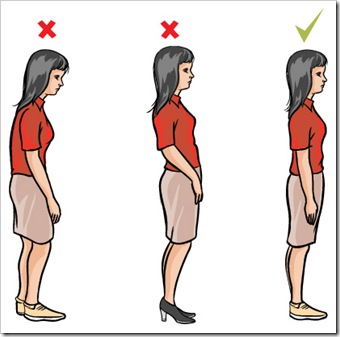 Good posture is essential to good spine health
Good posture is essential to good spine health
This is defined as ears aligned with shoulders and shoulder blades, retracted. In proper alignment, spinal stress is diminished. It is the most efficient position to achieve the best posture possible.
Deep belly breathing
Place your hands on your abdominal area and feel your belly move as you inhale and exhale. Do this as many times a day as possible to improve your posture and overall spinal health. This type of breathing enables the spinal nerves to move within the spinal channels, diminishing pain and providing a sense of well-being.
Targeted simple exercises
 Just 10 minutes a day is all you need to perform some spine-strengthening exercises.
Just 10 minutes a day is all you need to perform some spine-strengthening exercises.
Neck stretches, including bending and extension range-of-motion exercises, are a series of simple side-to-side, up-and-down and ear-to-shoulder stretches that can dramatically improve the health of the cervical spine.
Using light weights to improve posture and performing some yoga poses such as downward dog, which opens the chest and stretches the spine, can also improve spinal health. Push-ups can strengthen the spinal and postural muscles as well.
What you eat can directly impact your spine
You may not realize it, but your diet plays a key role. A healthy diet consisting mostly of lean proteins, healthy fats and lots of fresh fruits and vegetables is ideal for building a lean body and muscles that support the spine.
To improve the condition of your spine, take a multivitamin along with a B-complex and Omega-3s. They have been shown to decrease pain in the nerves of the spine.
Spend a little time in the sun every day
Believe it or not, the sun can have a positive effect on your spine. Sunlight energizes the whole body, literally waking it up and encouraging the body to stand up straighter.
Sunlight contains vitamin D, which is required for strong bones, including the spinal column, and is manufactured in the body through sun exposure. Try to spend 10 to 20 minutes in sunlight daily.
Pay attention to how — and how long — you sleep
Studies suggest insufficient sleep is associated with increased neck and back problems. It’s important to get a sufficient amount (between six and eight hours) and, of course, to sleep in a position that enables the spine to relax. The ideal position is on your side, as that puts the least amount of pressure on the spine.
Create a proper sanctuary for sleep, choosing a suitable mattress and pillow for comfort, eliminating all outdoor light and providing fresh, cool air. Avoid use of electronic devices at bedtime.
 Meditation
Meditation
Meditation can restore alertness, improve your mood, increase productivity and prolong life and have positive effects it can have on your spine and posture. People who meditate tend to focus on their core, automatically straightening their spines in the process.
To remind yourself to carve out about 10 minutes per day to perform these exercises and rituals (especially in the middle of a busy workday), you can set an alarm on your smartphone.
You can also use apps. Healthy Back Workouts provides three apps devoted to the neck and upper back, strong spine and core and posture and lower back. They’re designed to accommodate the beginner, intermediate or advanced individual with step-by-step photos and detailed instructions.
Source: www.grandforksherald.com; Pamela Knudson; June 2, 2013.








